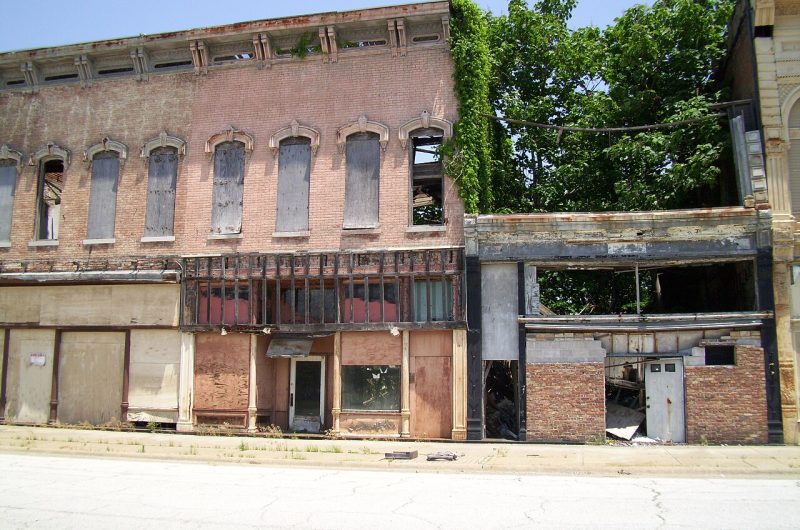2020-2023 Census Population Estimates: A Mixed Bag for UP Counties

“Northern Michigan, after years of struggle, is gaining residents again,” proclaimed a recent headline on a popular Michigan news website. The subject of the article was the Census Bureau’s recent release of its 2023 population estimates for Michigan counties.
And like a lot of attention-grabbing headlines, the devil lies in the details. Instead, the authors propose a more nuanced headline: it’s a mixed bag.
The population dynamics of the U.P. are well known. The birthrate has been falling for decades, in line with the overall drop in US fertility levels. At the same time an aging population is driving up the number of deaths. More deaths than births will produce a decline in population, unless that deficit can be offset by people moving to the area.
This article digs deeper into the latest population estimates to illustrate a more complex pattern.
The Upper Peninsula is isolated with an economy dependent upon natural resources. Mining closures have been part of the landscape for over a hundred years, while technological changes in the forest products industries require fewer workers. Air force base and prison closings have also been a part of the region’s economic landscape since the 1970s.
The net effect of these and other related processes is that when a mine or other facility closes, people move away. In the past, the numbers of people leaving have been partially offset by a high birth rate; that is no longer the case. In 2022, the number of births in the U.P. totaled 2,181, down 616 from 2010, a drop of 22 percent. Total deaths in 2022 were 3,514; 262 more than in 2010.
2023 Census Population Estimates

Given the region’s higher number of deaths than births, it might be expected that the region’s population would decline (Table 1). But that is not the case for the most recent population estimates.
Ten counties had a higher population in 2023 than in 2020, although it should be noted that the increases amount to less than 30 persons for several counties (Table 2). Nevertheless, the region’s population is up by 465 persons, an increase of .15 percent compared with the state’s drop of -.4 percent.

Keweenaw County had the highest percentage population gain in the U.P. (and state); although in terms of raw numbers its increase of 125 persons is relatively modest. These and other gains suggest that the Covid induced migration in 2020 that drew people to the U.P. to work remotely has been sustained.
It also provides some support for the idea that the region might be attracting migrants escaping areas that are most vulnerable to the effects of climate change in the South and West. This phenomenon was identified in a previously published article on Rural Insights ‘Recent U.P. Migration Trends and Their Economic Consequences.’
Between 2020 and 2021, for example, more households moved to the U.P. from Southern and Western states than moved in the opposite direction, marking a reversal in long term migration patterns. But some counties continue to lose population; a pattern that dates back to 2000 for Alger, Chippewa, Delta, Gogebic, and Menominee.
Discussion
Alongside the headline that prompted this article is a picture of the Eagle Harbor Lighthouse in Keweenaw County with the text noting that county has added nearly 200 people since 2020, ‘part of a trend of small population gains in rural areas.’ However, some U.P. counties continue to shed population as part of a long-term trend, while a detailed analysis of the U.P. at the zip code level illustrates wide disparities in economic well-being even among counties experiencing population gains.
The Economic Innovation Group (EIG) has developed a Distressed Communities Index that uses census data to sort regions into one of five well-being categories: prosperous, comfortable, mid-tier, at risk and distressed. Readers are encouraged to visit EIG’s web site at https://eig.org/ and follow the link to the Distressed Communities Index for a detailed explanation of the methodology used in compiling the Index.

Distressed communities are characterized by economic disinvestment, high levels of unemployment and poverty, along with low levels of educational attainment and labor force participation. There are eleven distressed U.P. zip codes (Table 3). Marquette and Houghton counties are experiencing population growth, yet each contains distressed communities tied to mine closures.
South Range’s fortunes started to decline in the 1920s, while Republic’s mine closed in 1982 and Palmer’s closed in 2016. Not surprisingly these closures have a significant impact. In Palmer, between 2017 and 2022, the number of jobs dropped by over 80 percent, while businesses declined 22 percent, epitomizing the characteristics of an economically distressed community.
Pelkie (Baraga), Hessel (Mackinac) and Kincheloe (Chippewa) have the highest distress scores in the U.P., and rank in the top 10 percent of most distressed zip codes within the state. Over 50 percent of prime age adults (25-54) in all three communities are not working, which is higher than many zip codes in Detroit. Yet Baraga and Mackinac are growing in population.
In short, even within counties that are gaining population, there are struggling communities.
Conclusions
Returning to the original headline that prompted this article. ‘After years of struggle’ some U.P. counties are gaining population as a result of migration. But as to whether this process will continue is an open question.
The benefits that newcomers bring are clear: an increased demand for goods and services as well as a boost to local taxes. But new arrivals have unintended consequences such as increasing the strain on rural health care services, and rising housing prices to make home-ownership out of reach for long-term residents.
Finally, the fact that some counties are gaining population, should not mask the continued population decline in other counties or the economic and social challenges that exist within distressed communities that are found throughout the entire region. In short, demographic change is truly a mixed bag.







Remote Workforce Keweenaw has tracked over 200 individuals working remotely in Houghton, Keweenaw, and Baraga Counties since the start of the initiative in late 2018. We continue to discover ones we were not aware of on a monthly basis. As an example, we are tracking 32 remote workers in Chassell Township alone with many of these working in various fields of information technology with stong representation in marketing, government, and engineering. Learn more about Remote Workforce Keweenaw at https://remoteworkforcekeweenaw.com and learn about those making the decision to locate here by following the Remote Workforce Keweenaw Facebook page at https://www.facebook.com/RemoteWorkforceKeweenaw.
I wonder, though, if remote working will attract a lot of permanent new residents to remote areas such as the UP. Young people want to be around other young people. They flock to urban centers such as the Twin Cities and, to a much lesser extent, to smaller urban places such as Green Bay. One way to increase population in the Lake Superior Region is to invest in Higher Education. At the moment, this is not happening; in fact, the trend is at best very mixed: Finlandia closed last year, and Northland has declare a state of “exigent financial emergency.”. We need the political will to spend public funds to enhance and expand opportunities for higher education throughout the Region: NMU, MTU, Lake Superior University, UW-Superior, UMD, as well as the community colleges. Consider the phenomenal success of the Free University of Berlin. After WWII, when no one wanted to live in West Berlin, the West German government created this tuition free university with transportation, housing, and other subsidies, as well as exemption from compulsory national service. The goal was to attract young people to Berlin. As a result of this highly successful policy, Berlin is now one of the hippest cities in the word, full of young peope, including thousands of Israelis! Governor Whitmer recently announced a $50 million grant to a Canadian mining company for a new copper mine north of Wakefield, projected to have a life-span of no more than 14 years. Then what? How about similar grants to higher education? Could not the state have given MTU a similar grant to absorb FInlandia, to house its liberal arts , nascent nursing, and teaching programs- much like Radcliffe is part of Harvard? [A factoid: Radcliffe was founded with money from Elizabeth Cabot Agassiz, the stepmother of Alexander Agassiz, the longtime president and a principal shareholder in Calumet & Hecla.]
The world is a bell curve and our strategy is to focus on those who embrace winter and value living in a place with ubiquitous natural beauty, no congestion, and lower crime. For those coming from metropolitan areas, our housing costs are significantly lower. We are finding that the many young people who have come to the Keweenaw are drawn to this value proposition. It is not for everyone, but this helps keep the growth manageable.
I agree: The Lake Superior Region has tremendous natural beauty, which is a definite draw for many. Have you factored in the crisis of rural health care? Many people want to live where they will have access to good quality medical care. Consider what has happened in Ontonagon: In the last 15 or so years, both of its nursing homes have closed. The Ontonagon Hospital closed this past week. Those are not welcome signs to encourage people of any age to settle there.
Sounds to smart to do plus it takes time our attention span in the USA is way to short for looking at growth. Back in the 40’s through the 60’s we expanded for everyone. The economy was great we all prospered, now the middle class pays for the growth of those at the top. It seems that prices for most items have doubled or tripled in some cases college costs an example my own kids went for $10 grand a year (late 90’s early 2000’s) now my granddaughter will be paying $30 grand a year while those wages have gone up minimally. This mostly the work of the republican’s cutting for the rich. We need to take back the economy for our youth. I say why no retirements any more? CEO’s making 425 to 1 ratio’s is just a start of the problem.
Remote Workforce Keweenaw tracking illuminates the less-visible remote workers. does anyone track the influx of climate refugees?
We have had remote workers from Oregon, Idaho, and D.C. all mention climate as being a factor in their decision to come to the Keweenaw.
Interesting that among economic departures listed in the research, there’s no mention of Ontonagon County’s loss of jobs in the late 1990s and into the 2000s. The closure of the White Pine Mine, along with the shipyard closure in Ontonagon and the additional closure of the Ontonagon mill (Smurfit-Stone) were all devastating economically. Workers traveled from far and wide to work at these places and I’d suspect that these closures may have been more broadly felt than the Republic or Empire Mine closures, save for those mines’ proximity to Marquette. Additionally, the closures of military bases also had a significant impact on the U.P.; makes me wonder about the scope of the research and how well population “growth” and demographics are studied by economists/social scientists.
Very good points. Adding to the industry losses for Ontonagon that you discussed , I mentioned in my earlier comments the closures of the two nursing homes there, and now the hospital. The closure by Aspirus of its long-term care facility in Ontonagon in 2022 or 23 caused 29 residents to be evicted and placed in L’Anse, Houghton-Hancock, or Ironwood-Wakefied etc. far from their homes and loved ones. Additiony 22 employees lost their jobs. At the time Aspirus announced it was closing its nursing home, it announced that it was going to build an approx. $12 million hospital. There was radio silence after that until Aspirus announced earlier this year that it was closing the Ontonagon hospital, instead of building a new one! When Aspirus acquired the hospital from the village of Ontonagon, Aspirus refused to assume the hospital’s unfunded pension obligation. Attempts by the then village president to create a payment program for this debt were rejected by Ontonagon voters [unwisely, in my opinion]. The capable village president himself was defeated in the next election. The pension debt was approx. $8.5 million. I don’t know what its status is at present. To add to the community’s woes, its railroad abandoned the village, and the state re-routed the highway around [outside] the community. We need a program akin to the Roosevelt era TVA for places like Ontonagon and the rest of the Lake Superior Region. It is unlikely that will happen with the Republican ascendency throughout the region.
Interestingly, the City of Gladstone bucks the trend with a population INCREASE of 5.7% 2010 to 2020, despite an overall drop in population for Delta County.
I expect this positive trend to increase, not just for Gladstone but many areas in the U.P.. I believe (based upon anecdotal information) this is due to remote work opportunities, water/air security migration, much lower home prices (vs. national average of $400,000), natural beauty, and (for Gladstone) a very safe, family-friendly environment due in part to a prohibition on recreational marijuana sales (Opt-out community).
Discussions of the pros and cons of legalized marjuana, as of alcohol, etc. are unending. I would like to see an independent study of the impact of legalized marijuana on the communities, beginning with my neighboring city of Ironwood, that have opted-in to have recreational dispensaries. Ironwood currently has five recreational marijuna dispensaries, all located on, or a half a block away, from Cloverand Drive [US Highway 2]. Such a study could begin by detailing how much he city of Ironwood is receiving in property taxes on the real estate occupied by the marijuna establishments vs. what it was taking it before they were constructed. In addition what does Ironwood receive in the special marijuana tax [marijuna regulation fund] ? Is there sales tax revenue? What has the city of Ironwood done with this increased revenue? How many peope are employed at the dispensaries? What are their salaries, including fringe benefits? Where do they live? Do they have families? What effect has their employment had on the job situation in Ironwood? What are the indirect effects from legalizing? Do consumers buy gasoine while in town? Do they stop at restaurants or fast-food shops? Do they do any other shopping in Ironwood? Do they use other Ironwood services. What negative effects have there been because of the dispensaries? Has crime increased in Ironwood, or has it decreased? Or has there been no discernible effect? Did the Ironwood public safety department hire more officers as a result of the dispensaries? Or did the pubic safety department reduce its staffing level? Is there a higher incidence of drug-related incidents/problems? Such a study would aid citizens greatly in making informed decisions about this growing phenonomen, which of course is not limited to Ironwood and the state of Michigan.